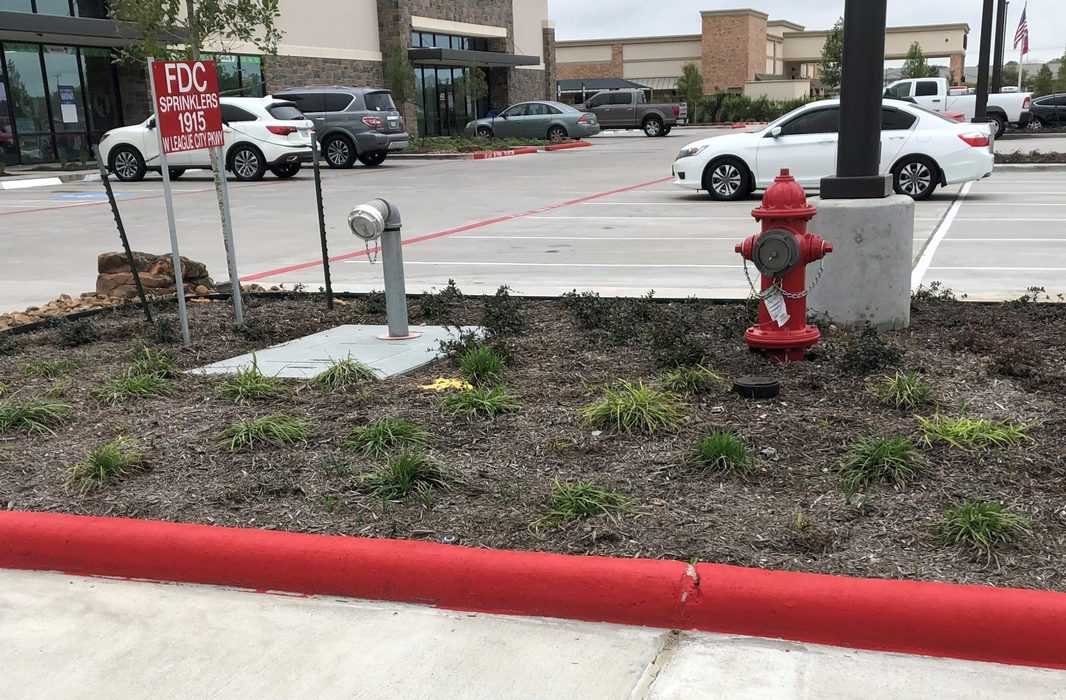Have you ever seen a Fire Department Connection and thought, “What’s that? I thought the Fire Department connected to a Fire Hydrant? What’s the difference?”
What is the difference between Fire Department Connections (FDC) and Fire Hydrants?
Simply put, a Fire Hydrant is a water source and water comes out, while a Fire Department Connection (FDC) is an inlet to allow more water to be pumped into the fire suppression system. The idea is that the Fire Hydrant is used to either attach a hose to directly and fight the fire or be used to fill the pumper truck. The pumper truck can be used to pump into the Fire Department Connection to provide additional water into the building’s fire sprinkler system or standpipe.
Fire Hydrants typically get the water from the domestic water supply which is the same city water that goes to our homes and businesses. However sometimes you will find Drafting Hydrants. These hydrants will get their water from a surface water source such as lakes, rivers, ponds, or could even be large swimming pools in Amusement Parks. The pressure and GPMs (Gallons per Minute) of each Fire Hydrant can vary due to city water demands, and system design but typically Fire Hydrants have a pressure of about 50 psi and a water flow capacity of around 1000 GPM.
Fire Department Connections can either be directly attached to the side of a building or located a distance away from the building. These are called either Freestanding or Sidewalk FDCs. NFPA 13 and the AHJ will specify exactly where to place the the FDC, typically on the street side and maybe even more specifically the address side of the building.
There should also be signage at the FDC to inform the responding fire fighters to:
- What type of system the FDC feeds? Automatic Sprinkler, Open Sprinkler, or Standpipe
- The water pressure required at the FDC to deliver the full system demand.
- If the FDC only provides water to a specific portion of the building or building complex, it must be shown clearly which portions are served by that FDC.
What is the distance from a FDC to a Fire Hydrant?
Without getting into each specific example and exceptions, the maximum distance from a FDC to a Fire Hydrant 100 feet per NFPA and IFC. The codes do make note that the Fire Marshal and Authority Having Jurisdiction (AHJ) have the final say in both location and distances for the FDCs. Many jurisdictions require a maximum distance of only 50′ while others may allow for up to 400′ in certain circumstances. AHJs can set minimum distances as well and I have seen 30′ a sort of standard if there is a minimum.
Fitting Types
Although some jurisdictions specify sexless fittings, generally the Fire Department Connection will have female fittings (threads on the inside and water goes in) and Fire Hydrants will have male fittings (threads on the outside and water goes out). Before construction, the design team should know what the Fire Marshal and jurisdiction specify for connection types and sizes. This will match up to the equipment and hoses that the fire fighting crews will have on their trucks when they arrive onsite. 2-1/2″ threaded inlets are very common in some areas, while 3″ threaded inlets are used in some major metropolitan areas such as San Francisco and New York City. Newer technology such as 4″ or 5″ “Storz” FDC connections are quickly becoming more and more popular for their quick connection quarter turn design. The moral of this story (and all stories that require the Fire Marshal’s input!) is to make sure you fully understand their requirements in the design phase and you don’t have any unneeded surprises (which lead to construction delays and additional cost) during an onsite inspection.
As with all industries, some equipment has industry specific slang and lingo. Fire Department Connections are sometimes called Siamese Connections if they have two twin female inlets connections that attach to a single body pipe. At the intersection there is a clapper valve that won’t allow the water to come out of the unused connection and directs it toward the building and the fire suppression system.
Fire Department Connection versus Standpipe versus Automatic Fire Sprinklers
As described above, the Fire Department Connection is a point where the firefighters can hook up their pumper truck and supply additional water volume and pressure to the building in the event of a fire. A Standpipe system is a pipe that runs up through a building, typically a high rise, and allows firefighters to operate hoses and manually fight the fire from the inside.
An Automatic Fire Sprinkler System has sprinkler heads throughout the building which come on automatically when a fire is detected and suppress the fire. Fire sprinklers that are built to comply with NFPA 13 will get their water supply from the same source as the building’s domestic water supply. In high rises a house fire pump may be included in the system design to ensure there is adequate pressure and water flow to the upper floors of the building. A fire department connection is meant as a means that the fire fighters can supplement the water supply, if needed, but is not designed or a specific volume and not meant to provide the sprinkler’s full demand of water.
There are a few reasons that firefighters may need to add additional water via the FDC:
- The domestic water supply to the building is currently inadequate to supply the needed volume and pressure to the fire sprinkler system. This could include a high demand on the water causing low pressures or even a closed valve on the water supply which cuts off the buildings water entirely.
- There may have been a change in building occupancy that now presents a greater hazard to the occupants than the sprinkler system was originally designed for.
- There may have been a failure of one of the building’s sprinkler system components such as the house fire pump. In this scenario there would not be enough pressure to reach the upper floors of a building and the Fire Department’s Pumper truck would need to pump into the Fire Department Connection to supplement and boost the water pressure.
Summary
In summary, both Fire Hydrants and Fire Department Connections (along with the internal fire sprinklers or standpipe systems) play key roles in the building’s fire protection strategy. Not any two buildings and scenarios are the same so it is always best when starting design on a new building or preparing for a renovation that the Architect and Design Engineers conference with the Fire Marshal to ensure what is designed is within their expectation and provides adequate protection to the facility and occupants.


